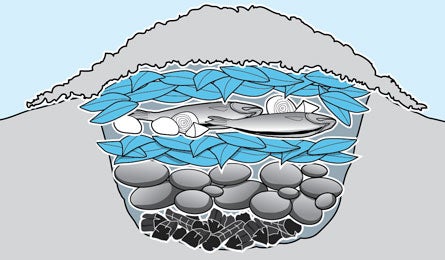Survival: Famished But With...No Cooking Pots

'A pit oven is a perfect way to cook without pots and pans.'
Steam-Cook in Zip-Top Bags
Unlike foil pouches, zip-top plastic bags won’t survive high heat. But you can steam-cook with them. First, place a flat rock atop a stove or fire. (Note: Avoid using river rocks; the latent water inside their crevices might cause the rocks to expand and fracture when heated.) Suspend a zipped bag containing your water and uncooked food (pasta, rice, vegetables, tea, etc.) directly over the hot rock. Drip water onto the rock to generate steam, which will cook the food without destroying the bag. Cooking times vary widely, but ballpark is 10 minutes.
Heat Pouches
To cook freeze-dried meals without a pot, remove the dry food from the foil pouch, fill it with water, and heat it over a stove or fire. When the water boils, add the food, and mix as instructed. Save the bag to heat additional water later.
Bake Dinner in a Pit Oven
If you’re feeling prehistoric, light a wood fire in a hole about one foot deep and three feet wide. When the fire peaks, add large rocks; as the flames die into coals, cover the rocks with wet, green plant material—the wetter, the better. Add a layer of uncooked food (red meat, fish, veggies), then a second layer of flora. Cover the pit with two to four inches of dirt and wait several hours until the food is cooked. (see illustration above)
Boil-in-the-Bottle
It is possible to boil water in plastic jugs—even flimsy #1 PET soda bottles. Since too much heat will melt plastic, shield the bottle from direct flames by suspending it from a cord or shoelace four to six inches above the fire. Spin the bottle to distribute the heat. Hard plastic bottles and water bladders are more heat-resistant, but still never put them directly in flames.
Survival Secrets
Use tent stakes—not poles—to create a grill over a fire, since they resist heat better.
A prickly pear pad effectively filters water. Slice the pad in half and place both halves, insides facing down, in the water container or well (let sediment settle in the container first). The pad’s thick gum will soak up most of the dirt and nasty bacteria after about 30 minutes.